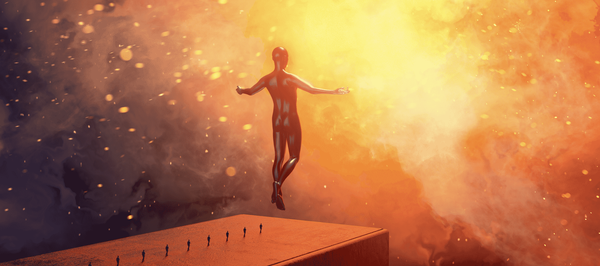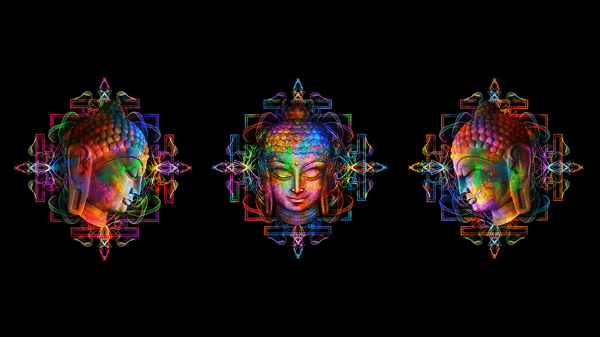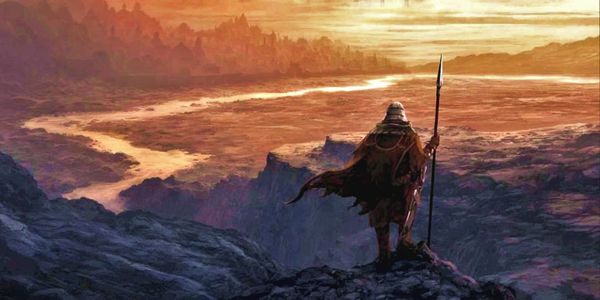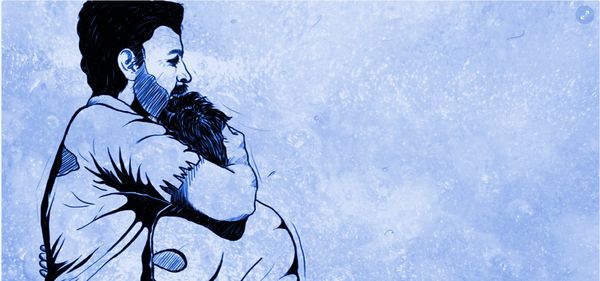Steve Taylor • • 21 min read
D.H. Lawrence on the Overdeveloped Ego and Our Connection to the Cosmos
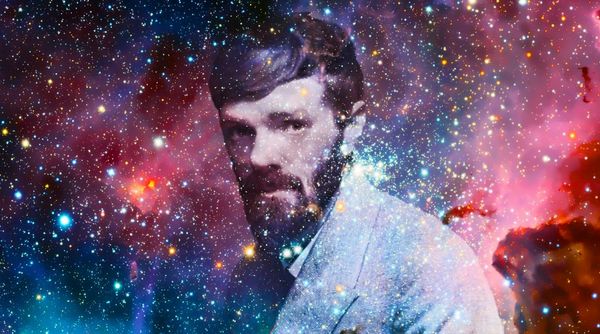
One of the major themes that runs through all of D.H. Lawrence’s work is that there is something ‘wrong’ with present-day human beings.
His attitude is as far removed from the optimistic humanism of his contemporary H.G. Wells as it is possible to be. Wells celebrated human invention and achievement, saw human history as one step forward after another, leading to the ‘advanced’ state of present day civilisation and further glories thereafter. But Lawrence’s trajectory of history ran the other way. He believed that modern human beings had degenerated from an earlier, healthier state and that industrial civilisation was heading irrevocably for disaster.
Because of these kind of views, Lawrence has a reputation for being a bad-tempered misanthrope, who was consumed with hatred of the human race. And it is true that some of his pronouncements do seem a little irrational and even hysterical – for example, when he writes, “how easily we might spare a million or two of humans and never miss them”[1] or “There are too many people on earth; insipid, unsalted, rabbity, endlessly hopping.”[2] Nevertheless, this picture of Lawrence is, I believe, flawed. Rather than being a cranky, subjective view generated by his own bitterness and bad-temperateness – or even his tuberculosis – Lawrence’s negative opinion of present day human beings was, from his point of view, justifiable and even inevitable. His sense that there was ‘something wrong’ with human beings came from a deep intuitive understanding of the human race’s early history and of the world’s pre-civilised primal peoples.
The Over-Developed Ego
Lawrence had two main complaints about modern human beings. One was what we could be referred to as our ‘mind-body’ duality, or our separation from our own bodies and instincts. We experience ourselves as an ego that lives inside our heads, an ‘I’ which continually chatters away to itself and busies itself with concepts and abstractions. Because we identify so strongly with this ego, we cut ourselves off from the deepest and most fundamental levels of our own being. As Lawrence expresses it in his poem ‘Ego-Bound’, we are like plants who are ‘pot-bound’ instead of rooted in the earth. Man is, he says, “enclosed in his own limited mental consciousness” and as a result he is only half-alive, and “can’t feel anymore or love, or rejoice or even grieve any more.”[3] This ‘I’ sees the body as something ‘other’ to it, a kind of vehicle that it lives inside but which is not it. And because of this separation, we think of the body as a kind of enemy. We feel ashamed of its nakedness and its sexual desires. We see it as something ‘lower’ than us, a kind of base animal, and in the same way that we feel impelled to dominate animals – and the whole world in general – we feel impelled to dominate the body, and to control and repress its desires.
Lawrence’s second main complaint concerns a different kind of separation: the separation between human beings and the cosmos. Rather than being part of the world, we are apart from it, detached observers who look at it as something ‘other’ to us – just as we do our bodies. The ‘flow’ of life between human beings and the cosmos has been broken. In Lawrence’s words, we are ‘separated off’ from the cosmos. Man has fallen into “awareness of himself, and hence into apartness.”[4] And because of this separation the phenomenal world is an unreal and dreary place to us. We all live in what Lawrence called “a marvellous rich world of contact and sheer fluid beauty and fearless face to face awareness of now naked life.”[5] But in a sense we do not live in this world. Because we are trapped in what Lawrence calls “the barbed-wire enclosure of know thyself,”[6] all of this beauty and aliveness is a kind of grey shadow reality to us. None of its incredible radiance and is-ness reaches us. As Lawrence puts it, “Nothing, nothing comes from the open heaven, from earth, from the sun and moon, nothing, nothing; only the mechanical power of self-directed energy.”[7]
We can see both of these complaints as expressions of the same fundamental problem. In both cases, the problem is human beings’ over-developed sense of ego. Our sense of I-ness, or of individuality, has grown so strong that we have become alienated from our own bodies and from the cosmos. We have become isolated inside what Lawrence calls “the glass bottles of our own ego” or “the cages of our own personality.”[8]
Lawrence did not, however, believe that these problems were fundamental to all human beings. He believed that they were particular to Europeans, and more specifically still, to modern Europeans. This strong sense of ego was only a fairly recent development. The people of ancient times had not become ‘separated out’ from the cosmos. They lived in oneness with it and were intensely sensitive to its beauty and aliveness. As he writes in Apocalypse:
Perhaps the greatest difference between us and the pagans lies in our different relation to the cosmos. With us, all is personal. Don’t let us imagine we see the sun as the old civilisations saw it. We have lost the sun. We have lost almost entirely the great and intricately developed sensual awareness, or sense-awareness, and sense-knowledge of the ancients.[9]
Because of their oneness with the cosmos, Lawrence suggests, these ancient peoples did not need gods. To them the whole phenomenal world was sacred, every tree, stone and river was pervaded with divine essence, and so there was no need to invent gods who lived outside the world. Gods only became necessary when we lost this connection to the cosmos. Or as Lawrence puts it:
The very ancient world was entirely religious and godless. While men still lived in close physical unison, like flocks of birds on the wing, in a close physical oneness, an ancient tribal unison in which the individual was hardly separated out, then the tribe lived breast to breast with the cosmos. The whole cosmos was alive and in contact with the flesh of man, there was no room for the god idea. It was not till the individual began to feel separated off… that the concept of a god arose, to intervene between man the cosmos. God and gods enter when man has ‘fallen’ into a sense of separateness and loneliness.[10]
Lawrence saw the Etruscans as one of these peoples. In Sketches of Etruscan Places, he contrasts the Etruscans with their contemporaries in Italy, the Romans. Whereas the Romans were obsessed with war and power, and the phenomenal world was an incidental backdrop to their ego-struggles, the vibrant artwork of the Etruscans suggests that they were awake to the is-ness and beauty of the natural world, and that they lived joyously and fully, without any sense of guilt or shame. To Lawrence, the Etruscans displayed, “the last glimpses of a human cosmic consciousness different from our own…The fag end of the revelation of another form of cosmic consciousness.”[11] In other words, they were one of the last European peoples who did not possess the over-developed sense of ego, and who were not, therefore, ‘separated out’ from the cosmos. With the coming of the Greeks, the Romans and other Indo-European peoples, this kind of consciousness faded away.
Outside Europe it lingered on, however. In some parts of the world it even managed to survive into the twentieth century. In Psychoanalysis and the Unconscious Lawrence explains this in terms of the ancient myth of the Flood. Before the Flood, all cultures shared a common ‘esoteric science’, based on their intense sensory awareness. But when the glaciers melted people were forced to flee to high ground, and their common culture fell apart. Some of them – such as the Greeks and Romans – forgot their ancient traditions, but others kept the old kind of consciousness alive, if only in a diluted form. As Lawrence puts it:
Some retained their marvellous innate beauty and life-perfection, as the South Sea islanders, and some wandered savage in Africa, and some, like the Druids or Etruscans or Chaldeans or Amerindians or Chinese, refused to forget, but taught the old wisdom, only in its half-forgotten, symbolic forms.[12]
Lawrence witnessed this at first hand in his encounters with Indian culture in New Mexico. He recognised that the Hopi Indians experienced the world through a completely different kind of consciousness to Europeans. And the essential difference, again, was that they did not experience a sense of separateness to the cosmos. The phenomenal world was as sacred and divine to them as it was to the Etruscans:
There is [to the Indian], in our sense of the word, no God. But all is godly. There is no Great Mind directing the universe. Yet the mystery of creation, the wonder and fascination of creation, shimmers in every leaf and stone, in every thorn and bird.[13]
This, then, was basically Lawrence’s view of history: earlier human beings lived in a state of connection to the cosmos and experienced the world as a fantastically vivid and beautiful place. They had a healthy acceptance of their own bodies and instincts, including a positive, guilt-free attitude to sex. But at a certain point human beings became ‘separated off’, and “fell into a sense of separateness and loneliness.” Some human groups developed a stronger sense of self, or ego, and at that moment they became disconnected from the cosmos, and disconnected from their own bodies and instincts.
The terminology Lawrence uses to describe this transition is, of course, borrowed from another ancient myth: the Biblical story of the Fall. In Apocalypse Lawrence explicitly states that the ‘fall into separateness’ occurred when man “ate of the Tree of Knowledge instead of the Tree of Life, and knew himself apart and separate.”[14] And if we look at the Fall story, it is easy to see why he makes this connection. The author of Genesis tells us that Adam and Eve live in a state of harmony until the serpent tempts Eve to bite into an apple from the Tree of Knowledge of good and evil. This brings death and disease into the world, and also seems to transform Adam and Eve’s psyche. They are now cursed with self-consciousness. They are aware that they are naked, and cover themselves with fig leaves. They are also suddenly “aware that there are things.” In other words, the Fall means developing a new kind of self-consciousness, which brings them a sense of separateness from their own bodies, and an ability to think abstractly. And Lawrence is claiming that the Fall actually happened, at least to European peoples.
It is important to remember that Lawrence had little evidence for these views, partly because in his lifetime the disciplines of archaeology and anthropology were both at an early stage of development. As in so many other cases, Lawrence’s views were largely intuitive. They were an example of the ‘subjective science’ which he believed ancient peoples practised, which operates through ‘sure intuition’ rather than through empirical investigation or intellectual reasoning.[15]
But how accurate was Lawrence’s intuition? Did the world’s ancient peoples really experience a different kind of consciousness to us, and do the world’s ‘primal’ peoples still experience this – or is he falling victim to the desire to idealise the ‘other’?
Archaeological Evidence
Archaeology has now given us a clear picture of the ‘very ancient’ world which Lawrence describes. In Europe this means going back before the Romans and Greeks, or even the Celts or Germanic peoples – in fact, before any Indo-European peoples invaded Europe and conquered its peoples. One of the peoples from this pre-Indo-European period were the Minoans of ancient Crete. Thousands of years before the Greeks, beginning at around 6000 BC, the Cretans developed a civilisation with a high level of technology, and a high level of craft specialisation and engineering work. They had multi-storied palaces and villas, networks of roads from one side of the island to the other, and large, well-organised towns. But what is most striking is not the level of technology they reached, but the kind of culture which they created. Archaeologists have been struck by the atmosphere of lightness and joy of Minoan culture, and its apparent sense of the sacredness of life and the beauty of nature. According to the archaeologist Nicolas Platon, for instance, “the artwork of the ancient Cretans showed a delight in beauty, grace and movement, and an enjoyment of life and closeness to nature.”[16] The walls and ceilings of houses were covered with paintings of plants, flowers and animals, and other popular art forms were frescoes of multi-coloured birds, beautiful golden miniatures and gracefully molded statuettes. Whereas later cultures were obsessed with death and the afterlife, for them the fear of death was almost obliterated by the ubiquitous joy of living.Another archaeologist, Sir Leonard Woolley, wrote that “Cretan art showed the most complete acceptance of the grace of life the world has ever known.”[17]
Read this: Mystical Science: Beyond the Frontier of Understanding
The Cretans also appear to have had a strikingly free and easy attitude towards sexual matters. Their culture showed what the archaeologist Jaquetta Hawkes, calls a “fearless and natural emphasis on sexual life that ran through all religious expression.”[18] Their art is full of sexual symbols, and Hawkes believes that sex ceremonies took place every Spring, to celebrate the earth’s fertility. However, their open attitude to sex is most evident from their paintings, which show both men and women wearing sexually provocative clothes. Women are bare-breasted, and wear what we would today call short ‘sexy’ skirts. Men wore codpieces, and short garments which revealed their thighs.
Nine years after Lawrence’s death Henry Miller visited the epicentre of ancient Cretan culture, the palace of Knossos, and his impressions were strikingly similar to Lawrence’s of the Etruscans. The art work and architecture of the palace of Knossus was, Miller believed, redolent of a “powerful and peaceful people”:
The prevailing note is one of joy. One feels that man lived to live, that he was not plagued by thoughts of a life beyond that he was religious in the only way becoming to man, by extracting the utmost of life from every passing minute.[19]
In the 1970s archaeologists began to realise that, rather than being an isolated culture, ancient Crete was part of a broad network of similar cultures, which were spread over a massive area of southern and eastern Europe and flourished between 8000 and 3000 BC. The archaeologist Marija Gimbutas called this ‘Old European civilisation’, in contravention of the traditional idea that civilisation began with the ancient Egyptians and Sumerians during the 4th millennium BC.
Old European civilisation in general appears to have had the same basic characteristics as Cretan culture. Most notably of all, the Old Europeans do not appear to have been war-like. No military weapons have been found at Old European sites, and unlike later civilisations – whose artwork was dominated by weapons and war – their artwork contains no depictions of warfare or violence. Instead, like the Cretans, their artwork was dominated by natural images. These were practically everywhere – images of the sun, water, serpents and butterflies, covering the outside and inside of houses, and the walls of shrines and public buildings.[20] But the major art form of the Old Europeans seems to have been small statuettes – or figurines – of naked women. Literally tens of thousands of these have been found, showing women with enlarged breasts and hips, sometimes in sexually inviting poses. Some archaeologists believe that these figurines had a religious function, others that they may simply have been an early form of pornography[21], but in any case they are clearly evidence of a free and easy attitude to sex and nakedness. We also know, as other evidence for this, that the Old Europeans placed vagina-shaped shells around the bodies of the dead – presumably to symbolise a return to the womb of the earth – and made a practice of painting vagina-shaped cavities inside caves with red ochre, presumably to symbolise menstrual blood.[22]
In other words, this archaeological evidence suggests that Lawrence was right. The reverence for nature that these peoples evidently possessed suggests that they had a sense of connectedness to the cosmos which we have now lost; and their positive attitude to sex and the body suggests that they had a sense of integration between their minds and bodies which we have also lost. And both of these together suggest that these peoples did not possess the modern over-developed sense of ego. They apparently had not ‘fallen into separateness’.
The high level of technology and social organisation of these cultures – which made Gimbutas feel entitled to use the term ‘civilisation’ – suggests another sense in which Lawrence’s intuitions were correct. Lawrence scorned the Wellsian view of human history as a slow progression from tribes of ignorant and primitive savages to the civilisations of Egypt and Sumer and the glories of Greece and Rome. He believed that there were other, earlier kinds of civilisation whose traces had not yet become visible. As he writes in Sketches of Etruscan Places, “The idea that our history emerged out of caves and savage lake-dwellings is puerile. Our history emerged out of the closing of a previous great phase of human history, a phase as great as our own.”[23] And this is exactly what Gimbutas’ discovery of Old European civilisation tells us.
Anthropological Evidence
How close was Lawrence’s view of the world’s primal peoples to what we now know of them? Here we are speaking of the peoples were once called ‘primitives’ or ‘savages’ – pre-literate and pre-civilised peoples such as the Australian Aborigines, the American Indians, certain African peoples, the peoples of Oceania, and the tribal peoples of Siberia and India. Nowadays many of these people’s cultures have either been destroyed completely or distorted by European influence, so they cannot really be called ‘primal’ anymore. However, we are fortunate that, in many cases, anthropologists managed to study these cultures while they were still in a relatively ‘pure’ state. Many of the most important anthropological studies were made during the two or three decades immediately following Lawrence’s death. In fact the British anthropologist Branislav Malinovski published his first study of the Trobriander islanders of Papua New Guinea while Lawrence was still alive, in 1927, although Lawrence appears not to have been aware of it.[24] Other important studies were Elwin’s study of the Muria people of India (first published in 1942)[25], E.E. Evans Pritchard’s study of the Nuer people of southern Africa[26] and Colin Turnbull’s study of the Pygmies of central Africa[27], both of which were undertaken in the 1950s.
Read this: How I Experienced the Sacred in Yosemite by Letting Go
Primal peoples in general appear to experience a deep sense of connection to nature. They appear to perceive natural phenomena as animate, with their own kind of consciousness or inner life. There are no ‘inanimate’ things to them – every tree, every plant, every rock and every river is alive. And what makes these things alive is the presence of Spirit inside them. Almost all – if not actually all – primal peoples believe that the whole universe and everything in it is pervaded with a spirit-force, or a kind of divine energy. In my readings of anthropological texts, I have yet to find a primal culture which does not have a term for this. In American, the Hopi – who Lawrence encountered in New Mexico – called it Maasauu, the Lakota Indians called it Wakan-Tanka, and the Pawnee Indians called it Tirawa.[28] In Africa, the Nuer call it Kwoth[29] and the Mbuti call it Pepo[30]; the Ainu of Japan called it Ramut[31], while in parts of New Guinea it was called imunu (translated by early anthropologist J.H. Holmes as ‘universal soul’[32]). All natural phenomena are seen as a manifestation of this spirit-force, and as a result all natural phenomena are seen as sacred. According to the African theologian Harvey Sindima, for example, to traditional African peoples, “All life – that of people, plants and animals, and the earth – originates and therefore shares an intimate relationship with divine life; all life is divine life.”[33]
Lawrence’s intuition that these peoples do not have concepts of God also appears to be largely correct. He was not completely right, since some primal peoples do have a concept of a creator God. But these creator Gods are very remote and detached figures who step aside once they have completed their creation and then have little or no significance. In general, there are no gods which control the events of the world and which they feel they have to pray to or worship. As Eliade writes:
Like many celestial Supreme Beings of ‘primitive’ peoples, the High Gods of a great number of African ethnic groups are regarded as creators, all-powerful and benevolent and so forth; but they play a rather insignificant part in the religious life. Being either too distant or too good to need a real cult, they are involved only in cases of great crisis.[34]
To primal peoples the divine is in the world, the spirit-force which pervades all things. As Evans-Pritchard wrote of the Nuer: “The anthropomorphic features of the Nuer concept of God are very weak and, as will be seen, they do not act towards him as if he were a man God is spirit, which, like the wind and air, is invisible and ubiquitous.”[35]
These peoples also have a completely open and shameless attitude to their own bodies and instincts. Most hunter-gatherer peoples live their lives either mostly or completely naked, and their sexual frankness is startling even by present day European standards. Sex is seen as a healthy and natural source of pleasure and is never an uncomfortable or clandestine subject. Adults talk about it freely and never try to shield their children from knowledge of it. As the anthropologist Robert Lawlor notes of the Aborigines, “The sex act itself is never hidden from children (although adult couples tend to prefer privacy). Children sleep in the same camp as their parents, and sex is an open topic of conversation.”[36]
Starting at a very young age – sometimes as young as 5 – Aborigine children play erotic games with each other, including mock lovemaking. They start having sex at what we would think of as a very young age too, sometimes even at the age of nine. In fact this seems to be true of all primal peoples. As Malinowski wrote of the Trobriander Islanders, for example:
The children initiate each other into the mysteries of sexual life in a directly practical manner at a very early age. A premature amorous existence begins among them long before they are really able to carry out the act of sex. They indulge in plays and pastimes in which they satisfy their curiosity concerning the appearance and function of the organs of regeneration, and incidentally receive, it would seem, a certain amount of positive pleasure.[37]
And once their sex lives actually do begin, the children of primal cultures have a degree of sexual freedom which most of us would find shocking. Sometimes children have their own communal dormitories, away from the adults’, where they regularly have sex with different partners. The most famous of these is the Ghotul of the Muria. This was a special ‘children’s house’ which adults were usually barred from entering, and where, according to some reports, children would be fined for having sex with the same person for more than three nights running.[38] Eventually, however, by the time of late adolescence, children do begin to ‘pair bond’. They form serious stable relationships, which lead to marriage. But even while married primal peoples have a great deal of sexual freedom. Many of them practise what we would today call ‘wife-swapping’, and sometimes when a man marries he assumes the right to have sex with any of his wife’s sisters, and the same for the wife with her husband’s brothers.[39]
Read this: The Fall: The Insanity of the Ego in Human History
And all of this, of course, fits very well with Lawrence’s views. Like our ancient ancestors, the world’s primal peoples do not seem to experience a sense of ego-separateness, and as a result feel a powerful sense of connection to the cosmos, and do not appear to suffer from a neurotic division between their minds and bodies. And the similarity with the world’s ancient peoples is not coincidental, of course – Lawrence also seems to be right in the sense that these primal peoples and ancient peoples like the Old Europeans seem to be essentially the same people, with the same form of consciousness. In some way primal peoples seem to be survivors from the world’s ancient past.
Lawrence’s State of Being
In one of his letters Lawrence complains of being described by his friend – and enemy – John Middleton Murry as “sort of animal with a sixth sense.”[40] But Murry’s description is apt. Lawrence’s powers of intuition were so powerful – and so accurate – that they sometimes do border on the supernatural. It is impossible to read the Birds, Beasts and Flowers poems, for example, without being struck by what Keith Sagar calls “Lawrence’s almost occult penetration into the being of other creatures.”[41] We can also see his ‘sixth sense’ at work in his famous ‘Letter From Germany’, written in 1924, in which – nine years before Hitler came to power – he detects a dark spectre of hostility and aggression forming, and eerily predicts the rise of Nazi Germany.[42] And after looking at the archaeological evidence, it seems that his ‘sixth sense’ is also working with amazing accuracy here, in terms of his views of human history and other cultures.
One of the most important points here is that Lawrence did not, of course, experience the modern ‘disease’ of ego-separation himself. He experienced the same profound sense of connection to the cosmos and the same integration between mind and body as the Old Europeans or the Aborigines. Because of this he was an outsider, who would always be estranged from his own culture and his own time. Lawrence knew this, of course, and interestingly, he was also aware that he really ‘belonged’ to the ‘pre-Fall’ cultures of the world. Towards the end of his life, in the essay New Mexico, he writes that in all of his years of travelling, the pre-European Indian culture of New Mexico was the place in which he felt most at peace and most at home:
I think New Mexico was the greatest experience from the outside world that I ever had. It certainly changed me forever. Curious as it may sound, it was New Mexico which liberated me from the present era of civilisation and the great era of material and mechanical development.[43]
The fact that Lawrence did not experience ego-separation is perhaps one of the major reasons for his greatness as a writer. The fact that he was not himself enclosed inside ‘the glass bottle’ of the ego gave him amazing powers of empathy and understanding, the ability to ‘enter into’ the beings of his characters and describe their inner lives so richly and vividly. Whereas his contemporaries (such as Wells) only seem to describe the ‘surface personality’ of their characters – the ego that deliberates, feels emotions and interacts with others and experiences everyday life – Lawrence goes deeper, to the non-personal, instinctive levels of their being. As he famously wrote of an early draft of The Rainbow to Edward Garnett, “You mustn’t look in my novel for the old stable ego – of the character I only care about what the woman is – what she IS – inhumanly, physiologically, materially.”[44] And perhaps the second great ability which his lack of ego-separation gave him was the amazing vividness of his writings, the powerful is-ness which they convey. His vision of the phenomenal world was so intense and acute – and his literary ability to communicate this so great – that to read one of his works is to actually experience the “marvellous rich world of contact and sheer fluid beauty and fearless face to face awareness of now naked life.[45]
In view of this estrangement from his own culture, it is perhaps not surprising that Lawrence’s view of his fellow human beings was so hostile. He was not merely a bad-tempered misanthrope who was bitter because his books and paintings were banned and critics did not understand his work. On the one hand, he had a justifiable sense of the ‘wrongness’ of present-day human beings in the context of ancient peoples and the world’s remaining primal peoples. He knew that the state of ego-separation which present-day human beings lived in was really abnormal. On the other hand, the psychic difference between him and his contemporaries meant that he felt alien to them, and experienced the enmity which goes with otherness.
And we should not forget that all of this went the other way round too, of course. Lawrence rejected his own culture – but his own culture also rejected him. To large extent, the misunderstanding and resistance he met with in his life can been seen as the inevitable result of this psychic gulf between him and his contemporaries. He was determined to celebrate the human body and treat sex as a sacred act, but as far as his contemporaries were concerned, with their neurotic separation from the ‘base animal’ of their bodies, this was depraved and disgusting.
Lawrence believed that the ultimate consequence of ego-isolation was the death of the human race. As he wrote in Nemesis:
If we do not rapidly open all the doors of consciousness,
and freshen the putrid little space in which we are cribbed,
the sky-blue walls of our unventilated heaven,
will be bright red with blood.[46]
But he was sometimes optimistic too. Despite his many doom-laden pronouncements, Lawrence intuited that a transformation could take place, that human beings could develop a new – and at the same time an old – way of relating to the world, and the life-denying materialism and puritanism of his age might be swept away by a new spirit of joy and harmony. As he wrote at the end of the The Rainbow:
And the rainbow stood on the earth. She knew that the sordid people who crept hard-scaled and separate on the face of the world’s corruption were living still, that the rainbow was arched in their blood and would quiver to life in their spirit, that they would cast off their horny covering of disintegration, that new, clean, naked bodies would issue to a new germination, a new growth, rising to the light and the wind and the clean rain of heaven.[47]
We can only hope that his powers of intuition were accurate in this instance too.
Originally published in the Journal of the DH Lawrence Society, 2004-5
References
- D.H. Lawrence, Complete Poems, London: Penguin, 1993, p.402
- Ibid, p.606
- Ibid, p.474
- D.H. Lawrence, Apocalypse, London: Granada, 1981, p.88.
- D.H. Lawrence, Complete Poems, op.cit., p.667
- Ibid.
- Ibid, p.675
- Ibid, p.482
- D.H. Lawrence, Apocalypse, op.cit., p.21
- Ibid, pp.87-88
- D.H. Lawrence, Sketches of Etruscan Places and Other Italian Essays, London: Penguin, 1992, p. 176
- D.H. Lawrence, Fanstasia of the Unconscious and Psychoanalysis and the Unconscious, London: Penguin, 1971, p.13
- D.H. Lawrence, Mornings in Mexico, London: Penguin, p.65
- D.H. Lawrence, Apocalypse, op.cit., p.88
- D.H. Lawrence, Fantasia of the Unconscious and Psychoanalysis and the Unconscious, op.cit., p.12
- In R. Eisler, The Chalice and the Blade, London: Thorsons, 1987, p. 32
- Ibid, p.32
- 18. Ibid, p.33
- H. Miller, The Colossus of Maroussi, London: Penguin, 1950, p.124
- M. Gimbutas, The Gods and Goddesses of Old Europe, Berkeley and Los Angeles: The University of California Press, 1982.
- T. Taylor, A Pre-History of Sex, London: Fourth Estate, 1996.
- R. Rudgley, Lost Civilisations of the Stone Age, London: Century, 1998.
- D.H. Lawrence, Sketches of Etruscan Places, op.cit., p.176
- B. Malinowski, B., The Sexual Life of Savages, London: Routledge and Keegan Paul, 1932.
- V. Elwin, V. The Kingdom of the Young, Bombay: Oxford University Press, 1968.
- E.E. Evans-Pritchard, Nuer Religion, Oxford: Oxford University Press, 1966.
- C. Turnbull, The Forest People, London: Pimlico, 1991.
- J. DeMeo, Saharasia, Oregon: OBRL, 1998.
- E.E. Evans-Pritchard, Nuer Religion, op.cit.
- C. Turnbull, The Forest People, op.cit.
- N. Smart, The Religious Experience of Mankind, London: Fontana, 1971.
- L. Levy-Bruhl, The Soul of the Primitive. London: Allen and Unwin, 1965.
- In Magesa, African Religion, New York: Orbis Books, 1997, p. 73.
- M. Eliade, From Primitives to Zen, London: Collins, 1967, p.6.
- E.E. Evans-Pritchard, Nuer Religion, op.cit., p.7.
- R. Lawlor, Voices of the First Day, Rochester, Vermont: Inner Traditions, 1991, p.173.
- B. Malinowski, The Sexual Life of Savages, op.cit., p.47.
- V. Elwin, The Kingdom of the Young, op.cit. V. The Muria
- A.A. Holmberg, Nomads of the Long Bow: the Seriono of Eastern Bolivia, Washington D.C: US Government Printing Office, 1950.
- D.H. Lawrence, The Collected Letters, London: Heinemann, 1962, p.1124.
- K. Sagar, ‘Introduction’, D.H. Lawrence, London: The Penguin Poetry Library, 1986, p.15,
- D.H. Lawrence, Selected Essays, London: Penguin, 1950.
- Ibid, p.181
- D.H. Lawrence, The Collected Letters, op.cit., p.282
- D.H. Lawrence, Complete Poems, op.cit., p.667
- Ibid, p. 514
- D.H. Lawrence, The Rainbow, London: Penguin, 1975, p.495.

